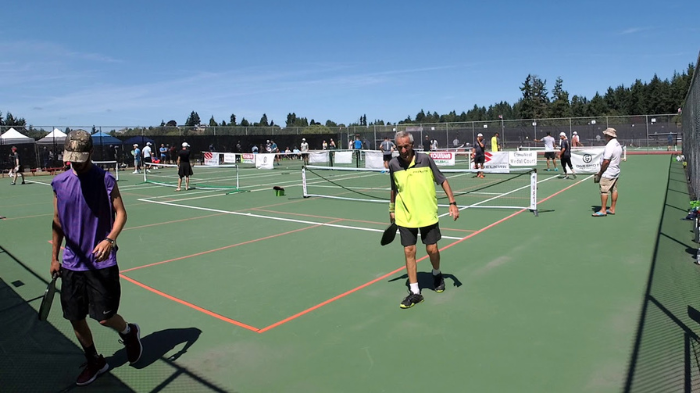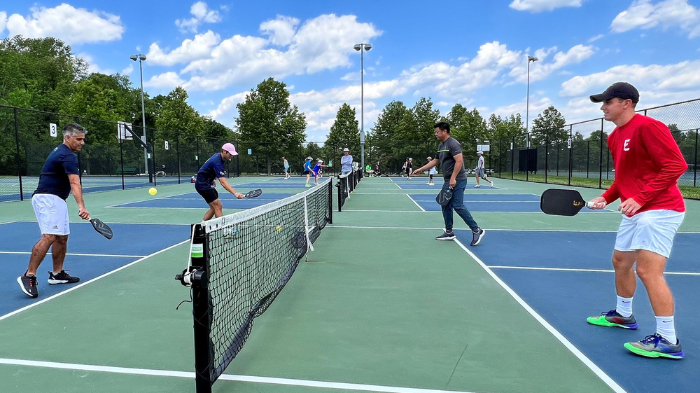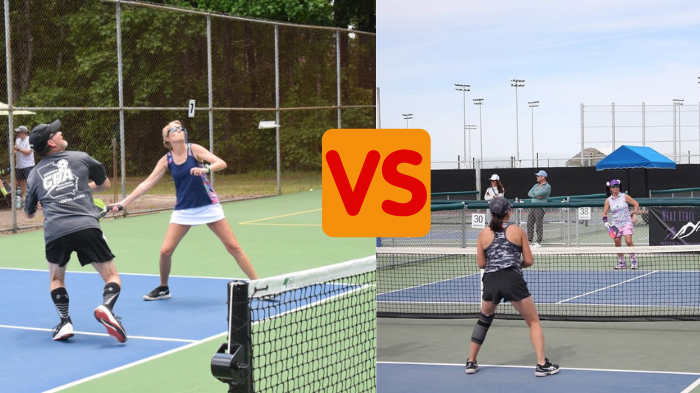Pickleball tournaments offer an exciting and competitive platform for players to showcase their skills and engage in spirited matches. To fully optimize your pickleball tournament experience, it is vital to acquaint yourself with the various pickleball tournament formats, grasp the differences between sanctioned and unsanctioned events, and delve into the organization of pickleball tournaments according to the age, skill level of players, and combination of both.
In this blog, we’ll dive into the four essential pickleball tournament formats, shed light on the differences between sanctioned and unsanctioned tournaments, and explore how pickleball tournament events are categorized based on age, skill level, and a combination of both. Let’s get started.
Four Types of Pickleball Tournament Formats
Pickleball can be played in various tournament formats, each with its own unique structure and rules. Now, we are going to explain four common types of pickleball tournament formats: Double Elimination, Single Elimination, Round-Robin, and Pool Play. Let’s have a look at each of the pickleball tournament formats in detail:
Double Elimination Tournament Format:
The Double Elimination format is widely used in many sports, including pickleball. In this format, participants or teams compete in a bracket with two potential paths to reach the final. Each team starts in the Winners’ Bracket, and if they win a match, they continue in that bracket. However, if they lose a match, they move to the Losers’ Bracket, where they still have a chance to reach the final.

In a Double Elimination tournament format, participants start in the Winners’ Bracket, competing against undefeated opponents. As the tournament advances, the victorious teams from the Losers’ Bracket get an opportunity to challenge the winners from the Winners’ Bracket. Nevertheless, if a team loses a match in the Losers’ Bracket, they are immediately eliminated from the tournament. Ultimately, the final match showcases the winner of the Winners’ Bracket against the winner of the Losers’ Bracket, determining the ultimate champion.
Single-Elimination Tournament Format:
The Single Elimination format is straightforward and commonly used in pickleball tournaments. In this format, teams or players compete in a draw, and each match is an elimination match. If a team loses a match, they are immediately eliminated from the tournament. The winners of each match move forward in the draw until the final match determines the ultimate winner.
Single-Elimination tournaments are renowned for their simplicity and efficiency, requiring fewer matches than other formats. However, these tournaments leave little space for error, as a single loss can swiftly result in elimination from the tournament.
Round-Robin Tournament Format:
The round-robin pickleball tournament format ensures that each player or team competes against every other player or team in the competition. In the round-robin tournament format, participants are divided into groups, and each group engages in a series of matches. The matches within the round-robin tournament format can be either prearranged in a specific order or scheduled by the participants themselves at their convenience within a designated time frame.
In a Round-Robin tournament, participants receive points based on their performance in each match. In this format, points are typically granted for wins, draws (if applicable), and occasionally, even for losses. After the round-robin stage, the participant or team in each group with the highest points goes to the next stage or the final, depending on the tournament’s format.

Pool Play Tournament Format:
The Pool Play format is similar to the Round-Robin format, but with a slight variation. In this format, participants are again divided into groups, commonly referred to as pools. Each pool is made up of a specific number of teams or players. The teams or players in each pool engage in matches against one another, following a format that closely resembles the Round-Robin structure.
Unlike the Round-Robin format, the Pool Play format often incorporates a playoff stage after the conclusion of the pool matches. After the pool matches, the top-performing teams from each pool advance to the playoff stage, where they engage in elimination matches to determine the ultimate champion. The Pool Play format offers a balanced and competitive tournament experience by providing participants with multiple matches and opportunities to progress, even if they encounter initial setbacks.
In conclusion, the Double Elimination, Single Elimination, Round-Robin, and Pool Play formats are popular tournament formats in pickleball. Each format offers a unique structure and set of rules, catering to different preferences and tournament sizes. Participants can enjoy the excitement and competitiveness of these formats while showcasing their skills on the pickleball court.
Unsanctioned vs Sanctioned Pickleball Tournaments
Unsanctioned and sanctioned pickleball tournaments differ primarily in terms of their official recognition and regulation by pickleball governing bodies. Here’s a breakdown of the differences:
Official Recognition:
A governing body officially recognizes sanctioned tournaments, typically the USA Pickleball Association (USAPA) in the United States or an equivalent national association in other countries. On the other hand, unsanctioned tournaments do not have official recognition or endorsement.
Rules And Standards:
Sanctioned tournaments follow the standardized rules and guidelines established by the governing body. These rules ensure uniformity and fairness across tournaments, including aspects such as court dimensions, equipment specifications, scoring systems, and player conduct. Unsanctioned tournaments may have their own variations or modifications to the rules, which can lead to some deviations from the standard game.
Player Eligibility:
Sanctioned tournaments often require players to be members of the governing body or affiliated with an official pickleball association. Occasionally, players may be required to meet specific ranking or skill prerequisites to participate in certain divisions or categories. Unsanctioned tournaments typically have more lenient eligibility criteria, allowing players of all skill levels to participate without any membership requirements.

Tournament Organization:
Sanctioned tournaments usually follow a structured format, including registration processes, specific age or skill-based divisions, and a defined tournament schedule. Certified referees typically oversee these events, ensuring adherence to stringent guidelines concerning court setup, equipment, and other logistical aspects. Unsanctioned tournaments often have a more informal structure, characterized by less strict organization and the possibility of having fewer officiating personnel.
Ranking And Rating Points:
Sanctioned tournaments often award ranking and rating points to players based on their performance. These points contribute to a player’s official ranking within the governing body’s system, allowing for comparisons and tracking of progress. Unsanctioned tournaments do not contribute to official rankings or rating systems, as the governing body does not recognize them.
Liability And Insurance:
Sanctioned tournaments often require liability waivers and insurance coverage to protect participants, organizers, and the governing body from legal and financial risks. Unsanctioned tournaments may not provide as much insurance coverage for participants, which means that individuals are more responsible for any potential risks or liabilities that may arise during their participation.
It’s worth noting that the specific details and variations between sanctioned and unsanctioned tournaments can vary based on the governing body, country, or region. It is always advisable to refer to the specific rules and guidelines established by the relevant pickleball association or organization to understand the distinctions and requirements for each type of tournament.
Pickleball Tournament Events Broken Down by Age And/or Skill Level
Pickleball tournaments are designed to provide a wide range of events that accommodate players of different age groups and skill levels, creating a dynamic and competitive playing environment. These events aim to offer inclusive opportunities for individuals of all ages and abilities to participate in and derive enjoyment from the game actively.
Now, let’s delve into how pickleball tournaments are organized, considering age categories, skill levels, and a combination of both to ensure an engaging and fulfilling experience for all participants:
Events By Age:
Pickleball tournaments often organize events based on age categories, allowing players to compete against others in their respective age groups. This segmentation ensures fair competition and provides a platform for players to showcase their skills among peers of similar age.
Age divisions can vary depending on the tournament, but commonly include categories such as juniors (under 18), adults (18-49), and seniors (50+). By organizing events by age, players can engage in spirited matches while fostering a sense of camaraderie within their age group.
Events By Skill Level:
Pickleball tournaments incorporate skill-level divisions to accommodate players with different levels of expertise. These divisions ensure that participants can compete against opponents who possess comparable abilities, thereby enriching the overall tournament experience and fostering a sense of balance in gameplay.
These skill-level divisions, commonly categorized as beginner, intermediate, advanced, and professional, ensure that players are appropriately challenged while providing them a fair chance of success, irrespective of their prior experience or skill proficiency in the sport.
Events By Age/Skill Level:
Some pickleball tournaments combine age and skill level divisions to create a comprehensive tournament structure. This approach allows players to compete against individuals who not only share a similar age group but also possess a comparable skill level.
By combining these two factors, tournaments can offer a more customized and inclusive playing experience, where participants can compete against opponents with similar abilities and life experiences.
FAQs
In a double elimination tournament, participants are given a valuable second chance to continue in the competition, as they have the flexibility to lose up to two matches before facing elimination. Conversely, in a single-elimination tournament, players are immediately eliminated from the competition after losing a single match, offering no opportunity for further participation or redemption.
Participants in a pickleball round-robin format are often put into groups, and each player or team competes against everyone else in their group. By guaranteeing that each participant has the chance to confront and compete against every other player or team in their group, this format encourages an inclusive and equitable playing environment.
By adopting the pool play format, participants engage in matches against opponents within their designated pool, resulting in an equitable and well-balanced playing experience. This format not only provides a greater number of matches but also enhances the opportunities for advancement to subsequent stages of the tournament. Ultimately, the pool play format creates an environment where participants can showcase their skills while enjoying a comprehensive and exciting competition.
Yes, players can participate in both sanctioned and unsanctioned tournaments as long as they meet the eligibility requirements and follow the pickleball tournament’s registration guidelines.
Conclusion
Being familiar with different pickleball tournament formats is essential for players looking to participate in competitive events. Understanding the distinctions between sanctioned and unsanctioned pickleball tournaments provides valuable insights into the organization, rules, and benefits associated with each.
In addition, having a clear understanding of how tournaments categorize events based on age, skill level, and the combination of age and skill level is crucial for players to choose the competitions that align perfectly with their abilities. This knowledge empowers players to maximize their tournament experience and fully immerse themselves in the exhilarating realm of pickleball. By being well-informed about these fundamental aspects, players can ensure that they can compete in tournaments that offer the ideal balance of challenge and enjoyment.



